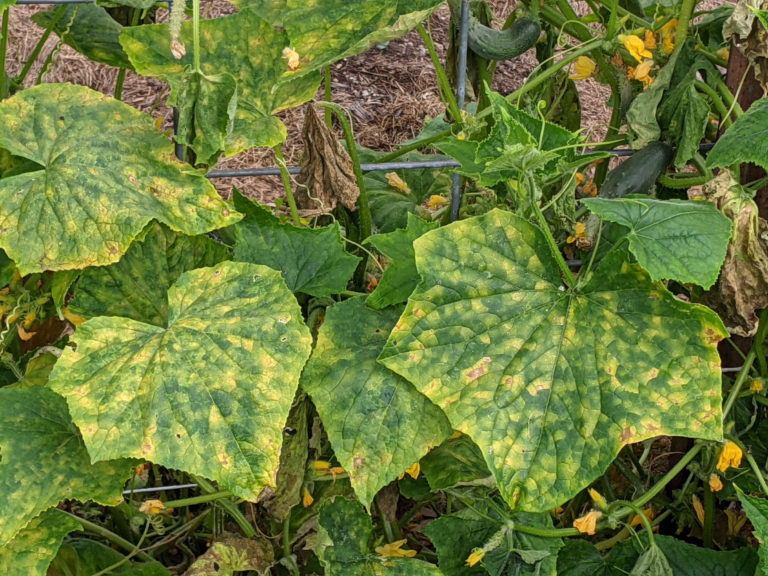Cucumber
Selection and Planting
Cucumber Varieties
Cucumbers come in all shapes and sizes from the smallest pickling cucumbers to the large and twisty varieties best when eaten raw. Even though the categories listed below produce different types of cucumbers, they are all grown in very similar ways.
Pickling cucumbers are those that have been bred to be very productive and form small fruit that remain crisp even after the pickling process. Just because a cucumber is listed as good for pickling doesn’t mean it cannot be eaten raw and used in place as a traditional slicing variety.
Slicing cucumbers have generally been bred to be uniform in size, straight, flavorful, and have a good shelf life. They have rougher skin and form seeds inside the fruit which means they must be picked early enough to prevent the seeds from maturing and becoming difficult to eat.
Seedless cucumbers have been bred to not form seeds inside the fruit. Along with this trait, they tend to have thinner skin and be much better to eat when compared to the traditional slicing varieties. We do not advise growing these at Rose Tree Garden because they are more susceptible to insect pests.
Planting
Cucumbers in Rose Tree Garden should always be grown from healthy transplants purchased from reputable garden centers or grown under lights from seed. If you are new to gardening, no not try growing plants from seed. Never try starting cucumber plants from seeds in the garden as they are very susceptible to pest damage as seedlings.
Pest pressures at Rose Tree Garden are higher than usual, so we encourage everyone to delay planting their cucumbers until no earlier than late May when the soil temperatures reach ~75 degrees F. Being one of the first plantings of cucumbers will make your plants a target.
Plant cucumbers in rows spaced 5-6 feet apart with 12 inches in between each plant. Be very gentle to the roots when transplanting to prevent damage. Spacing cucumbers too close will reduce airflow around the plant and increase the likelihood of disease forming.
Growing Cucumbers
Pests
Cucumbers are susceptible to a number of pests but none at the Rose Tree Garden more than the cucumber beetle which carries bacterial wilt. Regularly check the plants for signs of insect damage. Be aware of the pests that frequent peppers and use the links below to determine the best ways to control them.
Diseases
Growing cucumbers at Rose Tree Garden is exceptionally difficult due to bacterial wilt which is carried by the cucumber beetle. When the carrier beetle feeds on the plant, it passes the bacteria. Once infected, there is no way to stop the progression which leads to the sudden death of the plant. Prevention of the cucumber beetle is key in growing cucumbers.
For other diseases such as powdery mildew, cultural practices like those listed below will help keep your plants healthy and productive.
- Plant spacing: Cucumber plants that are positioned too close together will result in higher levels of humidity near the leaves due to air not being able to move between the plants. Making sure to give plants plenty of space will improve airflow and reduce the likelihood of disease
- Watering: Never water your cucumber plants by spraying the leaves. If spraying the leaves is unavoidable, water in the morning so the sun can quickly dry the water on the leaves.
- Crop rotation: A number of plant diseases come from a slow buildup in the soil over a period of time. Crop rotation (not growing plants in the same place every year) will keep the amount of soil disease low. Every year, move your plants to a different part of your garden that hasn’t hosted cucumbers for the past 3 years.
Watering
Maintaining consistent soil moisture levels will improve plant growth. Monitor both the soil moisture and rainfall using the Rose Tree Garden Weather Data and water your plants when soil moisture decreases or the garden has not received at least 1″ of rainfall in the past week.
When watering, be sure to avoid overhead sprinkling as this increases the likelihood of soil-borne diseases spreading to the plant. Water slowly at the base of the plant over a period of an hour to encourage deep root growth. Long and infrequent watering encourages the plant to focus on root development which will enable it to survive through periods of drought.
Weed Control
Keep area under pepper plants clear of weeds to prevent competition. Use a garden hoe or hand pulling to remove the weeds. Reduce the weed pressure by following our Weed Prevention suggestions.
Harvesting
Cucumbers should be harvested when fruit has reached the desired size indicated on the seed package or plant tag. All cucumbers will continue to ripen and get larger but this often comes at the expense of tender fruit. Fruit picked in the morning has more stored sugar than those picked in the afternoon or evening.


